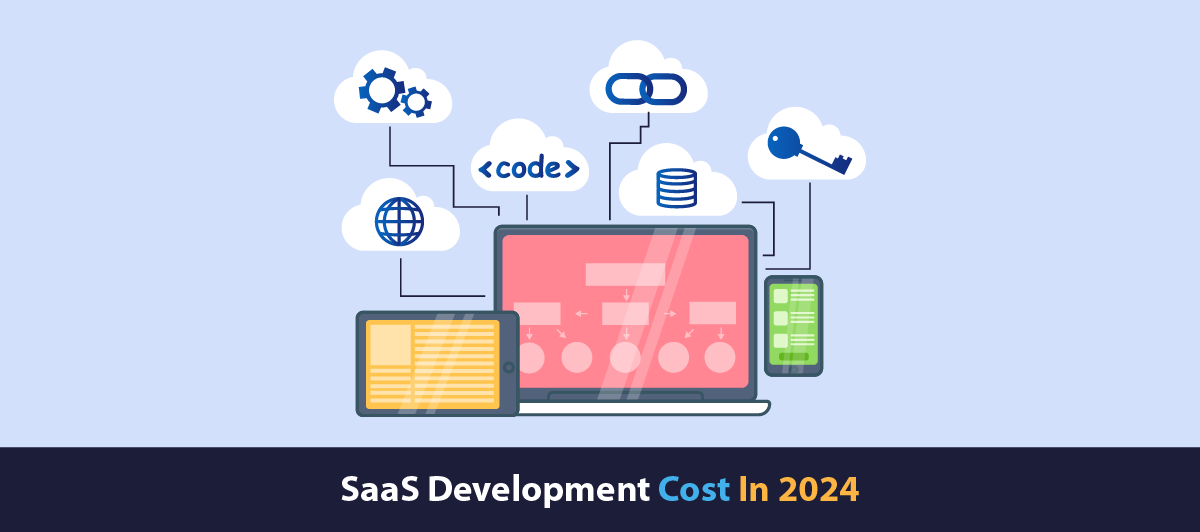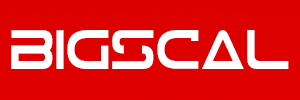What Will Be The Estimate SaaS Development Cost In 2024
Quick Summary: Whenever you think of starting a new SaaS App Development, determining cost is important. But how will you determine the cost? For that you just need to read this article! We will break down SaaS development costs. Additionally, we will also discuss basic features, importance, and key factors that affect SaaS development cost. So, keep reading!
Introduction
With the increasing popularity of SaaS platforms, most businesses are adopting this. But before initiating a project one must plan a budget and for that they will need to determine the SaaS development costs.
Businesses are fervently eyeing SaaS solutions to streamline operations, increase scalability, and embrace the digital age. However, the question is how to figure out the SaaS App Development Cost? And why is SaaS software development gaining so much importance?
Estimating the cost is not just about the numbers of cost. It’s about making strategic decisions, budgeting, and taking opportunities that move business forward. By understanding the complex costs of SaaS development, companies can navigate the competitive edge.
So, if you are finding ways to ascertain the SaaS software development costs then this article is for you!
We will consider several key factors. These include application complexity, technology stack used, development team expertise and location, ongoing maintenance and support costs, compliance requirements, and other integrations and processes. Furthermore, we will also discuss the features and advantages of SaaS products.
So, keep reading!
What should you know about SaaS and SaaS Application Development 2024?

Software as a Service (SaaS) is a software delivery model in which applications are deployed on a cloud infrastructure and accessed via the Internet. This model differs from traditional software deployments in that users do not need to install or maintain the software on their devices. Instead, the software can be accessed through a web browser. It allows it to be accessed from anywhere with an Internet connection.
Additionally in 2024, one of the most important models in software delivery and consumption is software-as-a-service (SaaS). SaaS applications are managed and hosted by a third party, are accessible via the Internet, and are generally licensed on a subscription basis. Understanding SaaS requires knowing its key characteristics, benefits, challenges and growth plans.
SaaS applications are popular for their flexibility, as they can meet different user requirements without the need for individual installations or updates. This scalability helps keep costs down. This makes it attractive for businesses looking for flexible software solutions. Additionally, SaaS providers handle maintenance, security, and other issues, reducing these burdens on users and allowing them to focus on their core applications.
Furthermore, the development of SaaS applications involves conceptualization, design, development, testing, implementation, and ongoing maintenance. An emphasis on user experience (UX). It ensures seamless integration with other systems are important elements of SaaS Application Development. In addition, SaaS providers should prioritize data security, compliance with regulations. These regulations are GDPR or CCPA and best practices in order to deliver a reliable and secure product.
Key Features Of SaaS App Or Platform
Let’s have a look at core features SaaS product development:
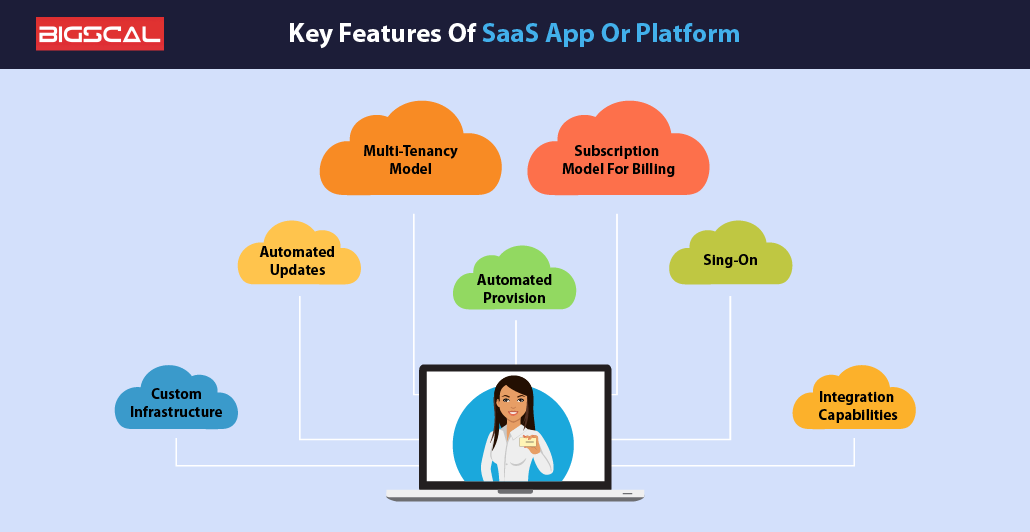
Multi-Tenancy Model
A multi-tenant model in SaaS products or apps allows multiple users or “tenants” to share the same software. Additionally, they can keep their data secure and separate. For example, suppose a room is a large apartment with a large room where each tenant has their own apartment. They all have the same amenities such as a gym or a balcony.
Similarly, in a SaaS multi-tenancy model, each user gets their own space in the software with customized configuration and data. But all have the same underlying infrastructure and codebase use the same. Therefore, this saves resources, simplifies updates, and provides a scalable solution for SaaS offerings.
Automated Provision
In SaaS terms, automatic provisioning refers to automated setup and configuration of resources. This includes servers, databases, and user accounts, without manual intervention. It is like having a robot configure everything needed to run your software has worked well. When someone else signs up for a SaaS platform automatic provisioning ensures that their account is created, necessary resources are allocated, and they can start using the software immediately.
For that they do not need for manual sign-in. This is not if it doesn’t happen time not only saves time. However, it reduces human error, improves scalability, of SaaS application. It also improves the overall user experience on the platform.
Sing-On
Single sign-on (SSO) is a feature in a SaaS application or platform. It allows users to access multiple applications with a single login credentials. Instead of remembering and assigning different user identifiers and passwords for each application. SSO simplifies the process by allowing users to log in once and gain access to all authorized applications.
This improve the user experience by reducing login problems. It also increases security when users are different. Forums rarely use weak passwords or reuse passwords.
Subscription Model For Billing
The subscription model for billing is a payment device normally utilized in SaaS packages. Instead of purchasing the software program outright, customers pay an ordinary charge at regular durations, commonly monthly or yearly, to get admission to and use the software. This model offers a number of benefits. These benefits involve, lower initial costs, flexibility to change functionality based on needs, spontaneous changes. Also, it includes maintenance, and the ability to test software before committing to a long-term purchase.
Integration Capabilities
This features is important, it allows users to streamline their workflows by integrating different applications. These applications includes customer relationship management (CRM) software, email marketing tools, or accounting systems, into a single platform.
For instance, a SaaS app project tools offers integration with popular cloud services. This services includes Google Drive, AWS Cloud, And Dropbox, etc. These tools enables users to attach files from these tools directly in the project management tools. Additionally, it includes payment options and API integrations. This allows users to for seamless payment and invoicing processing within SaaS platforms.
With its integration capabilities, SaaS apps allows to increase productivity, reduces tasks burden, and improve the efficiency. Moreover, with this feature they can manage their business operations efficiently.
Automated Updates
Automatic updates is the key feature of SaaS apps. These ensure users always have access to the latest version of the software. And for that they do not need a manual corrections. In addition, these updates may includes fixing bugs, security, and new features or improvements.
For example, suppose a SaaS applications receives a update notification. It will automatically start installing the new versions on the server. This makes it available immediately to all its users. Additionally, this automatic update feature also helps to maintain security of SaaS platform. It address all loopholes and fix it. With automatically update features, SaaS tool provider can deliver a secure and best experience to their users.
Custom Infrastructure
A SaaS (Software as a Service) app or platform with a custom infrastructure means it is specially designed to meet specific needs. This customization process ensures that the software works smoothly and runs smoothly, without unnecessary features that can slow it down. For example, if you do SaaS video editing your custom infrastructure may more easily include powerful servers optimized for large video files. This customized approach enhances performance and user experience.
Security
Security is crucial feature in SaaS app. It helps to protect data, prevents unwanted or unauthorized access, and ensure privacy. This security features include some major implications. These are encryption to encrypting data so that only authorized users can read it. Additionally, it includes regular security updates to fix vulnerabilities, and user authentication. Moreover, strong security measures in a SaaS app instill trust in users and protect sensitive information from cyber threats.
Advantages Of Developing SaaS Platform
Now it is necessary to understand exactly why and how SaaS project will benefits. So read below;
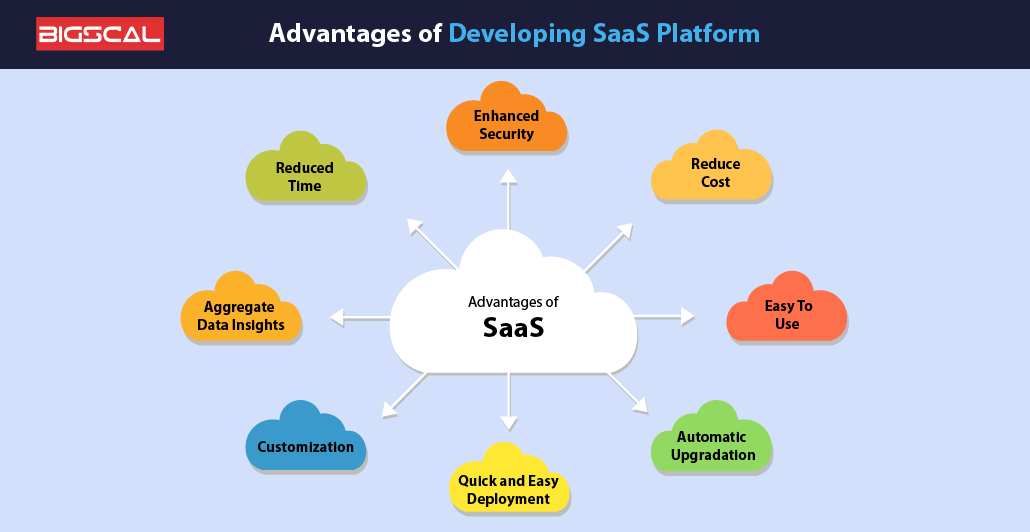
Reduced Time
The main benefit of using SaaS is that it reduce much time and it end up increasing productivity. In addition, it reduces the time required for software deployment and upgrades with its automatic update and deployment features. Unlike traditional software, which requires individual installation on each device. SaaS solutions are centralized and accessible with Internet. Therefore, this centralized concept makes the deployment process easy. It allows businesses to onboard users more quickly and efficiently.
Additionally, updates and patches can be applied easily by the service provider. Which ensures, users always receive the latest features and security improvements. And for that they do not need for manual intervention.
Enhanced Security
SaaS apps enhanced the security measures to protect user data and infrastructure. In addition, SaaS startups and businesses use advanced security technologies. These advanced techniques includes, encryption, multifactor authentication and regular security audits to protect against potential threats.
Additionally, the centralized data storage and management also helps to increase security. As it reduces the risk of data loss or breach from individual devices. Furthermore, SaaS providers remain vigilant about emerging security threats and deploy critical resources immediately. This allows businesses with a secure and reliable platform for their operations.
Reduce Cost
Another key advantage of using SaaS is, it reduce overall cost. SaaS platforms is that they cost less than traditional software models. With SaaS, businesses can eliminate the upfront investment. Like investment in hardware and software licensing as the service is often provided on a subscription basis. This subscription-based pricing allows businesses to customize their services according to their needs. And it also avoid unnecessary expenditure on unused resources.
Additionally, maintenance and support costs are often included in the subscription fee. Furthermore, it reduces overall cost of ownership. Moreover, SaaS platforms offer cost-effective solutions that enable businesses to distribute resources more efficiently.
Automatic Upgradation
SaaS platforms provide users with automatic updates and upgrades. It ensures that the users get access to latest features and improvements. This eliminates the need for manual updates. Which can be time consuming and error prone. Service providers are constantly upgrading their platforms based on user feedback and technological advances. It also offers users a seamless and customized experience, Automatic upgrades.
Thus, it improves user satisfaction and also enhance security and platform performance with evolving technologies. With the assurance of automatic upgrades provided by SaaS platforms businesses can stay competitive and accelerate their operations.
Quick and Easy deployment
One of the most important advantages of developing a software as a service (SaaS) platform is that it makes it faster and easier to deploy. Unlike traditional software solutions that require lengthy installation processes. SaaS applications can be accessed online without requiring complex configuration on users’ devices. This management process this simplification saves time and resources for providers and end users. It allows businesses to to quickly deploy their solutions and start reaping long-term benefits.
Customization
SaaS platforms another benefits is customization. Therefore, SaaS platforms offer a high level of customization. It allows companies to tailor software to meet their specific needs and preferences. This flexibility is necessary to meet the needs of different customers and industry standards.
Additionally, Through customizable features, companies can enhance user experience, improve productivity. With that they can solve unique business challenges in better way possible. These changes ensure that the software remains relevant and up to date with ever-changing market environment.
Aggregate data insights
Aggregate data insights is the ultimate benefit of developing SaaS platforms. SaaS platforms is their ability to aggregate and analyze vast amounts of data. By centralizing data from multiple sources, SaaS applications can generate valuable insights and trends that drive informed decision-making.
This data-driven approach empowers businesses to identify opportunities, optimize processes, and enhance overall performance. Moreover, SaaS platforms offer advanced analytics tools and reporting capabilities. And it end up enables users to visualize data comprehensively and derive actionable insights.
Easy To Use
SaaS platforms are designed with user-friendliness in mind. It makes them accessible and intuitive for a wide range of users. With user-friendly interfaces, simplified workflows, and guided functionalities, SaaS applications minimize the learning curve and maximize user adoption. Therefore, this easy to use feature improves user satisfaction.
Furthermore, it also boosts productivity as employees can quickly grasp the software’s features and leverage its full potential. For that they do not need extensive training or technical expertise. Moreover, the simplicity and accessibility of SaaS platforms contribute significantly to their widespread adoption and success in modern business environments.
Factors Influencing SaaS Development Costs and The Estimated Costs Based On These
Checkout this factors that influence SaaS implementation costs:
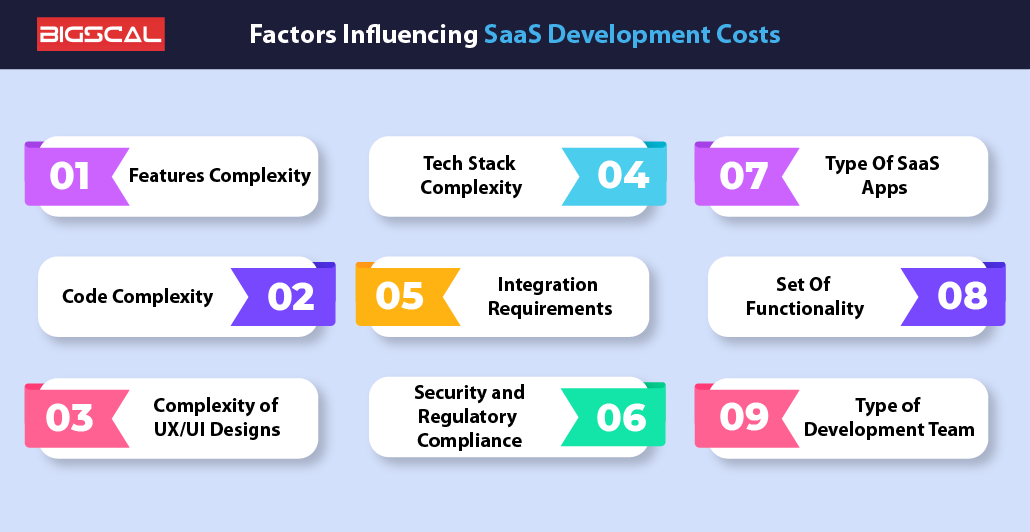
Features Complexity
Feature complexity refers to the complexity and sophistication of the combination of functionality and capabilities in a SaaS application. In addition to the advanced programming skills and extended development time required for complex features. These features includes real-time data processing, AI-driven analytics, and personalized user experiences. the integration of third-party API services can increase complexity and cost.
The average SaaS development cost ranges from $20,000 to $500,000 or more, depending on feature complexity. Basic SaaS services with fewer features fall on the lower end of the spectrum, while enterprise-grade solutions with advanced features command higher development costs.
Code Complexity
Another Key factor that influence the SaaS development costs is Code complexity. This complexity includes database design, and general regulatory requirements. A highly complex code base characterized by complex algorithms, scalability challenges, and complex security measures requires extensive expertise and careful development efforts.
The average cost associated with complex code in SaaS development can vary widely, typically from $30,000 to $1,000,000 or more. Factors such as the choice of programming language, configuration, and the need for continuous integration with the deployment pipeline affect the overall cost.
Complexity of UX/UI Designs
The complexity of UX/UI designs is major factor that affects the cost of SaaS development process. UX (User Experience) and UI (User Interface) are important determinants of how users interact with the software. So, simple and flexible design require less efforts and less time to develop, Thus, it means it reduce SaaS MVP costs. While, complex designs with multiple features, custom graphics, and communication features demand more resources. This includes, design skills, time and iteration, and lead high costs arise.
Hence, a simple UX/UI design for an average SaaS product can cost $5,000 to $15,000. This includes wireframing, prototyping, user testing, and design implementation. But for more complex models that include customization, detailed graphics, and user-tailored navigation, the price can rise significantly, from $20,000 to $50,000 or more than that.
Tech Stack Complexity
Another key factor that affects SaaS startup budget is which tech stack you choose. The tech stack includes, programming languages, frameworks, libraries, and infrastructure. Therefore, if you use a simple tech stack and popular technologies like, JavaScript, Python, or Ruby on Rails, then it can be cost-effective. Whereas, if you go with complex technologies, then you may be charged for more cost.
For a moderately complex tech stack that includes cloud-based infrastructure, microservice architecture, and integration with third-party services. The average cost for such tech stacks cost can range from $20,000 to $100,000. However, a very complex tech stack that coupled with the use of advance technologies and innovative features. These features and technologies may include, Blockchain, AI, ML, etc. Such kind of tech stacks takes the higher costs which may be more than $100,000. Further it depends on project demand and requirements.
Integration Requirements
The cost of SaaS app development may also vary with the integration requirements. If you are integrating various third-party services, API integration, cloud storage, databases, or legacy systems can add complexity to the development process. And all these integration requires careful planning, coding, testing, and often ongoing maintenance.
Hence, the more complex the integration environment, the higher the development cost. The average integration requirement can contribute anywhere from $10,000 to $50,000.
Security and Regulatory Compliance
As you know security is mandatory for SaaS application. When you need to handle sensitive data or working in regulated industries. These industries involve healthcare, finance, etc. Complex security measures such as encryption, authentication. Access control and implementation of data backup require significant knowledge and resources.
In addition, complying with industry-specific regulations and standards adds additional complexity and costs. On average, security and compliance checks can add $20,000 to $100,000 to SaaS development costs, depending on the level of security required and the regulatory environment.
Type Of SaaS Apps
The complexity and functionality of a software as a service (SaaS) application plays an important role in determining its development cost. Simple apps that provide basic functionality such as document management or job tracking are inexpensive to develop. Whereas, complex enterprise solutions such as customer relationship management (CRM) systems or enterprise resource planning (ERP) software.
If the average cost to develop a simple SaaS app can range from $10,000 to $50,000. It can be anywhere from a few million dollars , depending on the size and features required.
Type of Development Team
The structure and expertise of the development team also affects SaaS development costs. A team of experienced developers, designers and project managers. They often order as compared to a multi-skilled team or freelancers. In addition, the location of a development team has can affect costs.
On average, hiring an experienced development team for a mid-sized SaaS project can cost between $100,000 and $500,000. With larger projects requiring investments of $500,000 to several million dollars.
Location Of SaaS Companies
The location of SaaS Development Companies highly affects the costs. It vary the costs due to staffing levels, infrastructure costs, and regulatory requirements. The countries in North America and Western Europe, generally incur higher development expenses. e.g. $100,000 to $1,000,000 or more, depending on the complexity of the project and the skills required
In contrast, SaaS companies in countries with lower labor costs such as Eastern Europe, India, and Southeast Asia often offer competitive pricing. Development costs in these regions can range from $50,000 to $500,000 similar services. However, it is important to consider factors such as language barriers, time differences, and cultural nuances when outsourcing development in these areas, as they can affect project timelines and communication. Companies from the EU prefer to be nearshore and hire developers in Europe, whereas tech companies from the US usually choose to hire offshore developers in Latin America or Southeast Asia.
Set Of functionality
The range of functionality required for a SaaS application is another important factor affecting development costs. Basic SaaS solutions with features such as user authentication, data storage, and basic analytics. Charge less price. The average cost can be vary from $50,000 to $200,000. Additionally, these cost can be vary depending on the selected technology stack.
Furthermore, complex SaaS applications with advanced functionality. Like, real-time collaboration, AI-driven searches, integration with third-party-services, and extensive customization options can increase development costs. Such projects can range from $200,000 to more than $1,000,000 depending on the size and scope of the facilities.
Why Bigscal Technologies Can Provide You a Cost-Effective SaaS solution?
Are you seeking technical help with an affordable android app development company look no further than Bigscal Technologies. Wondering why? Read Below:
At Bigscal Technologies we excel in developing high level SaaS products. Our team members have an extensive knowledge of SaaS. They can develop scalable software architectures. Additionally, our developers specialize in resource efficiency, which translates to reduced service costs for our clients. Additionally, with us you can hire google drive developers.
Furthermore, we effectively use cloud computing technology to provide flexible pricing models based on usage, thereby avoiding unnecessary costs for unused resources. Our focus on automation is Continuous Integration/Continuous Deployment (CI/CD) pipelines. This also help reduce operational SaaS costs, as well as simplify development and deployment.
In addition, we prioritize open technologies and recyclables in our development approach. This not only reduces licensing costs but also promotes an efficient and cohesive development environment.
Conclusion
So, now as we are concluding this article, we hope you understand all intricates of SaaS product development costs. We explained all factors that may affect the cost. Additionally, you guys have also read the benefits of developing SaaS, and SaaS key features. However, at last we would like to recommend companies to prioritize quality and measurability when considering budget constraints. Hence, partnering with experienced development partners, using agile methodologies. And incorporating new technologies can improve cost efficiencies and ensure a successful SaaS solution.
FAQ
What are SaaS business logic?
The Business logic of SaaS are the rules and processes that is embedded within SaaS app. These rules help to run the functionality, control the user interactions, handles data, and administrate overall operations of SaaS app.
Explain software development agency or SaaS company.
The software development agencies are IT companies that build or provide custom solution to various industries. Whereas, SaaS company provide a apps that users can access with internet or online.
What is minimum viable product?
MVP or minimal viable products is the 1st version of any application. The MVP provides a overview about the app like how it looks etc. It helps to get customer’s feedback.
How Much Does It Cost to Build a SaaS Application?
There are various factors that affects the cost of software as a service SaaS. These factors are:
- Complexity
- Team Type
- Team Location
- Development time
- Selected Tech stacks, and more.
However, the overall cost can be $50,500- $150,500 and more.
What are core responsibilities of SaaS developers?
The Core responsibilities of SaaS developers are:
- Designing
- Developing
- Creating MVP
- Maintaining and Consulting
